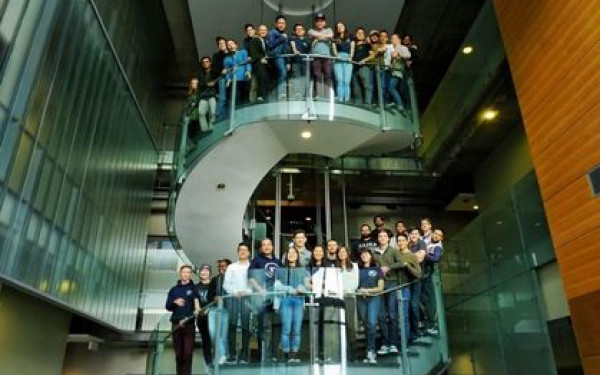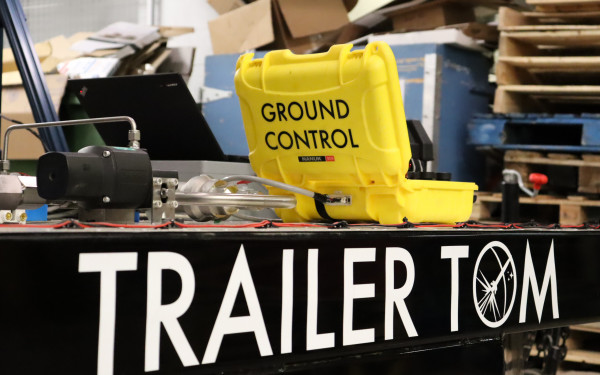Life on Mars
Tweeting Rover Reignites Public Imagination When It Comes to Space
Touching down on Mars. Date: Aug. 6, 2012. 12:25 a.m. EDT.
“Entering Mars’ atmosphere. 7. Minutes. Of. Terror. Starts. NOW. #MSL,” said the Mars Rover Curiosity over Twitter.
Right on time, at 12:32 a.m., came another tweet: “I’m safely on the surface of Mars. GALE CRATER I AM IN YOU!!!”
Back on Earth, hundreds of thousands were following the feed—and over three million were watching live online.
Like a burning freefall through an atmosphere, things were getting heated. By the end of the night, even the flight director—and his mohawk haircut—was an Internet phenom. In one night, his 200 Twitter followers ballooned to over 14,000.
But of course, there was no robot talking to anyone. Human progress has come a long way, but as of yet real artificial intelligence has eluded us. The real voice behind the persona was only human. Three humans, to be exact.
Veronica McGregor is the principal brain behind the Mars Rover Twitter account. A Montreal native, her father was a graduate of Loyola College, while her mother attended McGill University. Now, she is the director of communications for the National Aeronautics and Space Administration’s Jet Propulsion Laboratory in Pasadena, CA.
The Original Tweeting Spacebot
McGregor started experimenting with robotic personalities in 2008, when she thought to give the Phoenix Lander the Pinocchio treatment as it made its way through the Martian arctic, looking for frozen water samples.
Looking back, McGreger wasn’t sure what to expect.
“Honestly, when I first wrote in first person, I just sat there and waited and cringed and thought: I’m going to get people writing back saying, ‘That’s silly—don’t do that,’” she said.
McGregor had only expected a couple of hundred followers—just a few major space enthusiasts, really—in time for the rover’s landing. Instead, the whole campaign went viral. It was the fifth-most-followed account on Twitter in the summer of 2008, garnering over 40,000 followers by mission’s end.
People were hungry for answers. Until then, NASA had to rely on the mainstream media to reach anyone.
“Up until that point we relied heavily on the news media,” she admitted. “We got great feedback from people. They really appreciated even just a one-sentence update every day on the mission—and it opened up that door for people to be able to send us questions.”
Not surprisingly, others around NASA started to take notice. New NASA Twitter accounts started popping up. The project manager for two other Mars rovers—Spirit and Opportunity—wanted McGregor to manage those accounts as well.
But there was a catch: no first-person robots.
“I said, I can do it that way, but you’ll not get the followers you can get from first-person.”
Objectively, she was right, though McGregor said the missions’ outreaches have still been very successful.
As a talking robot, Phoenix was exuberant, enthusiastic and extremely excited. But it also had to put on a brave face—it was going to die in a few months.
“People started writing us back, [asking] ‘Why do you have to die? Can’t you move?’” she said, holding back a small chuckle.
“And I had to be this very brave little robot, saying, ‘It’s okay; I don’t want to be anywhere but here. This is amazing!’”
Out of the Ballpark
Phoenix was one thing, but by the time Curiosity was launched, popular interest had blown past the stratosphere.
“In the week prior to landing, we had over 374,000 tweets that were related to the Mars Curiosity Rover, and that could have reached a potential 1.2 billion people,” said Jason Townsend, social media coordinator for NASA in Washington, DC.
“That’s like knocking every ball out of the ballpark as a homerun,” he admitted.
But compared to previous rovers, everything about Curiosity is bigger.
“She is the biggest, most capable rover ever sent to another planet,” said McGregor matter-of-factly. “We gave her a real sense of bravada—and she knows she’s a big tough rover,” she added.
Curiosity hosts the most comprehensive chemistry set ever assembled for a rover mission. It hasn’t even used most of its tools yet, according to McGregor.
The big mission goals—determining methane deposits, finding water and other signs of life on Mars, past or otherwise—are only just underway. Curiosity has yet to even collect any drill samples.
Two-Way Learning
Interest is still high as the Curiosity mission continues—thanks in part to McGregor and her team’s daily in-character tweets. According to McGregor, it’s social media that’s driving the public’s imagination.
“What’s really wonderful is now we have this two-way communication ability with the public,” she explained. “We’ve learned so much from the public about what information they’re looking for and what they need cleared up. It was this real eye-opener for us.”
Townsend sees a similar role for social media.
“I think it’s really important to engage with the public. We’ve got millions of people who follow us right now on all of our social media accounts who agree with that,” he said.
“It’s a way for us to connect directly with them: to share as much as we possibly can about what we’re doing, our missions, our people, our programs, and really connect—kind of pull that curtain back and see what’s going on here.”
McGregor said social media is also great for engaging more and more young people, who she says are asking about scientific careers.
But one of the biggest gifts of social media is reaching everyday people and fostering their scientific interest, she said.
“Our goal is to always try and get people interested in what we call STEM: science, technology, engineering and math,” she said.
But space is only one of many arenas making progress. Around a third of all research conducted at JPL is actually in the earth sciences, according to McGregor.NASA also has social media accounts and programs dedicated to these fields, including an app called Earth Now, which allows users to follow NASA satellites.
“We’re doing more on that front to get people connected with NASA,” McGregor said. “Because the most important planet to study is our own.”

_1_900_598_90.jpg)
_600_832_s.png)



2_600_375_90_s_c1.jpg)
